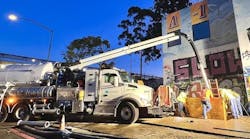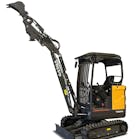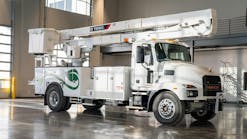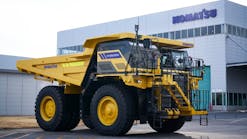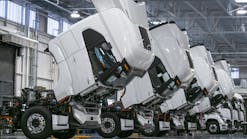“Sustainability.” It is largely a word popularized in the 21st Century, seen just about everywhere, and now the construction industry—as old-school as it can often seem—is no exception.
But in the iron world, is it merely “Look at us!” window-dressing to check a box for investors and environmental activists and avoid the ire of green-leaning politicians, or is it genuine?
Can it mean anything for fleets other than an extra initial expense?
It likely depends on an individual fleet’s goals, and how much they value lowering emissions and their carbon footprint. Over the long-term, there will be savings on diesel, for certain.
Looking at some OEMs, fleets, and rental equipment providers, there are many concrete steps being taken in the name of “Environment and Social Governance” and sustainability.
How is construction equipment going sustainable?
On the OEM side, John Deere is one company that has stated 2022 Sustainability Goals specifically for its products. They are reducing environmental impact, including CO2 emissions, on 90 percent of new products; increasing the use of sustainable materials by growing remanufactured and rebuild sales by 30 percent; and increasing recyclable, renewable, and recycled content.
More specifically to construction, Deere has partnered with National Grid, a northeast U.S. electricity, natural gas, and clean energy delivery company that is striving to be carbon-neutral, on a backhoe solution that supports its sustainability objectives.
The E-Power backhoe loader, an all-battery prototype built off the current 310L backhoe loader, 100-horsepower diesel equivalent was the result.
Previous product experience with the Deere hybrid electric wheel loader line helped the company select and integrate an electric drive system for its first battery electric backhoe prototype. Deere adopted a phased approach to focus development of key systems and accelerate collaborative testing with National Grid.
The initial phase of the E-Power backhoe was engineered by Deere, utilizing customer input and expertise from enterprise technical experts to help accelerate the team’s knowledge in battery systems, battery charging strategies, and electrified auxiliary components.
The next phase of the project will integrate feedback from National Grid’s testing as well as build on the Phase 1 experience to increase run-time and maximize the backhoe operator experience.
Brian Hennings, Deere product manager for backhoes, said the E-Power, with its electric power source, is expected to reduce carbon dioxide emissions by up to 83 metric tons over the life of the product while eliminating more than 7,300 gallons of diesel fuel. Being all-electric also means it runs quieter, currently reducing diesel decibel levels from the noise made by a kitchen blender to the sound of a clothes dryer.
“It makes for a safer work environment,” said Jon Gilbeck, manager for Production Systems-Site Development and Underground. “Communication is key between the operator and other support crew members. It also is less disruptive in neighborhoods or near businesses.”
“The target is performance and controllability in an all-electric backhoe similar to the diesel offering,” Hennings said.
Currently in Phase 1 proof of concept, the E-Power backhoe is being put to work in real-life job site scenarios. Hennings said that if further testing goes well, the battery electric solution could be made commercially available in a matter of years.
But, Gilbeck said, the benefits of having the E-Power backhoe in the field has “generated great conversations with customers across all production systems,” helping Deere take a broader view and prioritize future investments.
Deere says it expects to leverage insights from the E-Power backhoe across multiple product lines to have not only a backhoe, but up to five or six different machine forms that are fully electrified, putting the company on a path to a greener earthmoving fleet.
Volvo Construction Equipment already has five electric machines available for sale in North America, and it has inundated the industry with marketing regarding its electric machines and hydrogen fuel cell testing.
These are by no means the only two companies embracing hybrid technology, electrification, and fuel cell research.
What do equipment managers think of electric machines?
Fleet managers are generally open to the possibilities with electrification, but many are not sure how to proceed.
Ben Tucker, CEM, director of equipment and facilities for Barriere Construction in Metairie, Louisiana, has more questions than answers when asked about electric equipment.
“Personally, I’m a little nervous with that, especially if you’re running a 24-hour operation,” he said. “When are you going to get time to charge this thing back up? Because you’ve got to have an extra piece [for charging equipment]. Or, maybe you get into a situation like they had in Texas when a freeze comes and knocks the whole grid out. What are you going to do then?
“As far as efficiency and running, if you’re on a set time schedule, then I think it’s achievable,” Tucker said.
“Where and how are we going to fit in with this [technology]?” Tucker said. “I think it will help with security some, too, believe it or not, because every job site is going to have some kind of power station to charge these things. Are you going to have a generator charging everything? Are you coming off the grid with it? Maybe solar technology is going to be there. But, if it’s working over the day, how’s it going to charge at night?”
David Bolderoff, CEM, fleet manager in the fleet management and transportation section of the Los Angeles County Sanitation Districts, has been an advocate of alternative fuels and electrification at least as far back as 2015. For fleets looking into electric equipment, he said rental may be a good starting point.
Indeed, the rental sector has become a more important equipment provider, particularly with managers facing today’s delays on new equipment deliveries. Rental companies, including Sunbelt (Bobcat) and United Rentals (Takeuchi) are already partnering with OEMs on electric, zero emissions equipment.
“Sunbelt Rentals has kind of shown, with the mass purchase of the Bobcat CTL, that electric can work, and some of the smaller stuff, I would maybe just plug it into a 100, rather than needing a dedicated charger,” Bolderoff said. “But people like Sunbelt are kind of solving the charging issues with that machine where they’ll get you a charger for that machine if you need it more than a day.
“The rental company can pick it back up at the end of the day and solve the charging issue themselves,” Bolderoff says. “I think it could be definitely viable with the compact machines; I think with the bigger machines it would be more difficult.”
He also recommended experimenting with light-duty machines and the on-road side of the fleet first.
“I think the easiest stepping stone and what we’ve done is get your feet wet on the light-duty side,” Bolderoff said. “Installing charging infrastructure is a challenge; every project is a little bit different, particularly if you’re going below ground and putting infrastructure in. The cost could vary greatly on where you’re pulling that power from.
“Some manufacturers like Ford and GM have announced they’re coming out with electric pickups, so most fleets have large inventories of pickup trucks that support their operation,” Bolderoff says. “Maybe get some of these pickups in the fleet first, get some of the charging infrastructure in there and figure out that solution [on how] to keep your on-road fleet powered,” Bolderoff said. “And then you can see if there are some heavy-duty trucks that you could also potentially pilot with the infrastructure there.”
Bolderoff suggests that fleets demo compact electric equipment such as a mini excavator, wheel loader, or CTL, or rent one from the local rental house.
“See how that works, get feedback from your operators, find out what they like and what they don’t like,” Bolderoff said. “OEMs aren’t always going to have the answer unless we give them good feedback, so I think it’s important that we get these in the hands of our operators or our technicians and let them kick the tires, let them see this technology, and provide feedback to manufacturers.
“As they’re increasing their product lines on these, they can circumvent some of the problems if the more people that see them provide that feedback,” Bolderoff said. “OEMs are kind of waiting for us to show that demand, they need us to show demand for it and prove it’s wanted out there in the industry.”
On the larger contractor side, sustainability discussions inevitably become more corporate.
Worldwide contractor Bechtel says it is committed to achieving net zero emissions by 2050, and it is currently in the process of setting interim targets that align with the findings of the UN Intergovernmental Panel on Climate Change. Its intent is reducing emissions first (not offsetting), followed by carbon removal in order to counteract any remaining emissions as it nears its goal.
The company acknowledges that electric vehicles have been available for some time, but adoption has always been too low to attract significant investment and displace the internal combustion engines (ICE) in a meaningful way.
However, now Bechtel has recognized that EVs are in the process of displacing a significant portion of the traditional ICE vehicle market, which presents interesting opportunities.
There will be a wave of EVs hitting the market in a few years, and that market will see significant growth. But to support the growth of the EV market, significant investment in charging infrastructure is needed, and the company has acted.
Although automakers are investing heavily in the development of battery-powered models, without adequate charging infrastructure to recharge those vehicles, consumers will be reluctant to purchase them. In fact, the lack of EV charging stations is often cited as a key hurdle for consumers who are thinking about making the switch from an ICE to an EV.
Around the world, particularly in Europe and China, big investments are being made and policies are being implemented to address the lack of EV infrastructure. North America, however, is generally lagging on the EV infrastructure front. The International Council on Clean Transportation recently reported 88 of the top 100 U.S. metropolitan areas have less than half of the total charging infrastructure needed to support the EVs expected to be on the road by 2025.
Charging infrastructure
Bechtel says that to be ready for the future of electric vehicles in the next three to five years, the company needs to think big and build the critical charging infrastructure in North America at large scale.
Bechtel and General Motors are collaborating to build a large-scale Direct Current (DC) fast-charging network in North America.
“At Bechtel, we believe EV charging presents a compelling opportunity for our company as it combines three of our traditional markets—power, transportation, and communications infrastructure—and is representative of what defines us: building important large-scale projects,” says Kelley Brown, global communications lead, Bechtel Infrastructure and Power.
“Our goal is to build a large-scale charging network across North America so that ‘range anxiety’—worry about an inability to find a charging station—is no longer an impediment to purchasing an EV,” Brown says. “We believe in a clean future and think this is one of many important steps in that direction.”
And rental companies are also looking to receive, and provide, feedback. United Rentals has recently completed pilot programs for a new line of electric equipment and currently offers electric and hybrid equipment to help reduce emissions and energy costs.
Electric or hybrid units represent approximately 20 percent of its rental fleet. Categories include electric forklifts, aerial lifts, skid steers and mini excavators, solar-powered towable light towers, and LED light towers.
The company said it regularly communicates with customers and OEMs to discuss trends, changing needs, and future equipment offerings. It evaluates new products as they come to market to help meet the needs of customers and provide them with the most innovative, sustainable, and efficient equipment available in the industry.


